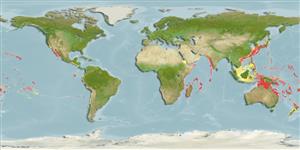Common names from other countries
Environment: milieu / climate zone / depth range / distribution range
Ekologi
laut berasosiasi dengan karang. Tropical
Western Pacific: Japan to Australia and the Kermadec Islands. Recently reported from Tonga (Ref. 53797).
Size / Weight / umur
Maturity: Lm ? range ? - ? cm
Max length : 5.0 cm TL jantan/; (Ref. 2334)
duri punggung lunak (Keseluruhan (total)): 12-43; Sirip dubur lunak: 22 - 40. Body fully scale. At least some of the dorsal saddles reaching a distinct lateral band. Combined number of soft rays in dorsal and anal fins usually 49 to 55 (Ref 12874).
A cryptic species that occurs on sandy or gravel bottoms. Pointed snout is used for burrowing; eyes directed upwards for sighting prey. Found from shallow tide pools to at least 150 m (Ref. 2334). Eyes move independently and possess a refractive cornea, a convexiclivate fovea and a non-spherical lens (Ref. 50869). Neither cleitheral spine gland nor anterolateral glandural goove with gland is present (Ref. 57406).
Life cycle and mating behavior
Kematangan | Reproduksi, perkembang biakan | Pemijahan | telur-telur | Fecundity | Larva
Randall, J.E., G.R. Allen and R.C. Steene, 1990. Fishes of the Great Barrier Reef and Coral Sea. University of Hawaii Press, Honolulu, Hawaii. 506 p. (Ref. 2334)
Status IUCN Red List (Ref. 130435)
CITES (Ref. 128078)
Not Evaluated
ancaman kepada manusia
Harmless
penggunaan manusia
informasi lanjut
AcuanBudidaya airprofil budidaya airStrainGenetikaElectrophoresesDiturunkanPenyakit-penyakitPengolahanMass conversion
mitraGambarStamps, Coins Misc.Suara-suaraCiguateraKecepatanTipe renangArea insangOtolithsOtakPenglihatan / visi
Alat, peralatan
laporan khas
muat turun XML
Sumber internet
Estimates based on models
Preferred temperature (Ref.
115969): 18.2 - 28.8, mean 27 (based on 664 cells).
Phylogenetic diversity index (Ref.
82804): PD
50 = 0.5156 [Uniqueness, from 0.5 = low to 2.0 = high].
Bayesian length-weight: a=0.00389 (0.00180 - 0.00842), b=3.12 (2.94 - 3.30), in cm Total Length, based on all LWR estimates for this body shape (Ref.
93245).
Trophic level (Ref.
69278): 3.0 ±0.00 se; based on food items.
Fishing Vulnerability (Ref.
59153): Low vulnerability (10 of 100).
